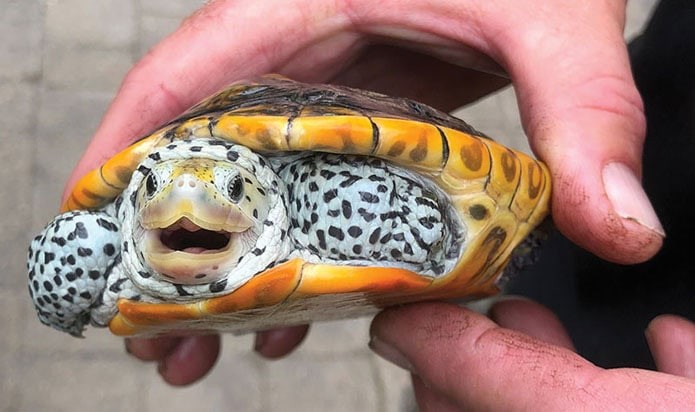Keeping pets can be a rewarding experience, and for those fascinated by reptiles, turtles often come to mind. If you have a pond and are considering adding a turtle, you might be wondering, “Can You Put A Pet Turtle In A Pond?” The short answer is yes, but it’s not as simple as just releasing a turtle into any pond. Creating a suitable environment is crucial for their health and well-being. Drawing from decades of experience in pond construction and turtle keeping, this guide will walk you through the essential considerations for successfully housing pet turtles in your pond.
Understanding Turtle Needs in a Pond Environment
Before introducing a turtle to your pond, it’s vital to understand their natural habitat preferences. In the wild, most aquatic turtles thrive in calm, shallow waters with abundant vegetation. They are not fans of fast-moving water or large waterfalls, which are often features in decorative ponds. Think of natural turtle habitats – they are typically found in slow-moving rivers, lakes, and swamps, areas that offer both aquatic and terrestrial environments.
To replicate a natural setting in your backyard pond, consider these essential features:
- Calm Water: Turtles prefer still or gently moving water. Strong currents can stress them and make it difficult to swim and bask.
- Shallow Areas: Turtles need shallow areas where they can easily enter and exit the water and feel secure. Varying depths within the pond are ideal.
- Basking Spots: Turtles are cold-blooded and require basking spots to regulate their body temperature. These areas should be easily accessible, sunny, and out of the water, such as logs, rocks, or sandy beaches.
- Vegetation (with caution): While turtles appreciate vegetation for cover and potential food, they can also be destructive to pond plants. Select hardy plants or consider artificial alternatives.
Designing and Building a Turtle-Friendly Pond
Creating a pond specifically for turtles requires careful planning and construction. Here are key aspects to consider during the design phase:
Pond Size and Depth
The size of your pond will depend on the type and number of turtles you plan to keep. However, a general rule is to go as large as your space and budget allow. A larger pond offers more stable water conditions and space for turtles to roam. Depth is also crucial; aim for an average depth of 12 to 24 inches, with shallower edges and deeper sections to accommodate different turtle behaviors like basking and overwintering.
Filtration and Water Quality
Turtles can produce a significant amount of waste, so efficient filtration is essential to maintain clean and healthy water. A bog filter is an excellent choice for turtle ponds. Bog filters utilize plants and beneficial bacteria to naturally filter water and are less likely to be disrupted by turtles compared to skimmers. Avoid using skimmers, as turtles are curious and may get trapped or damage the pump. Instead, opt for a wet well for pump placement, which keeps the pump accessible for maintenance but protected from turtles.
For water circulation, a gentle flow is sufficient. A bubbling rock feature can add visual appeal and improve oxygenation without creating strong currents that turtles dislike.
Basking Areas and Landscaping
Ample basking areas are non-negotiable for turtle ponds. Incorporate large, flat rocks, driftwood, or logs that extend out of the water, providing dry, sunny spots for turtles to warm up. Consider creating a sandy beach area adjacent to the pond. This not only serves as a basking spot but also provides a suitable location for female turtles to lay eggs. When landscaping around the pond, choose sturdy plants that can withstand potential turtle activity or opt for perennial plantings and sand in areas accessible to turtles to minimize plant damage.
Turtle-Proofing Your Pond
Turtles are notorious escape artists. To prevent them from wandering off, consider building a raised pond structure using bricks or similar materials. Walls with overhanging ledges can further deter escapes. While in-ground ponds can be used, they are generally less secure for containing turtles long-term. If using an in-ground pond, ensure the perimeter is well-secured with appropriate barriers.
Choosing the Right Turtle Species for Your Pond
Not all turtle species are equally well-suited for pond life, especially in outdoor environments with varying climates. Some of the best turtle varieties for ponds, particularly in regions with colder winters, include:
- Painted Turtles: These are hardy and beautiful native North American turtles, known for their colorful markings.
- Red-Eared Sliders: Adaptable and common in the pet trade, red-eared sliders are also relatively hardy and can overwinter in ponds in many areas.
- Yellow-Bellied Sliders: Similar to red-eared sliders, yellow-bellied sliders are another good option for pond environments.
These species are generally adaptable to pond life and can tolerate cooler temperatures, making them suitable for outdoor ponds in many climates.
Considerations for Multiple Turtles
If you plan to keep multiple turtles, be mindful of their potential breeding behavior and aggression. If you have both male and female turtles, they may breed. Provide suitable egg-laying sites, like sandy areas, for females. Male turtles can sometimes become aggressive, especially during mating season. Overcrowding can exacerbate this issue. In situations with multiple turtles, especially males and females, monitoring their interactions and providing ample space and resources is crucial. Separating males and females, particularly during overwintering, might be necessary to prevent harm to females due to excessive mating attempts.
Feeding and Caring for Pond Turtles
Providing a balanced diet is essential for the health of your pond turtles. A varied diet for pond turtles can include:
- Duckweed: Turtles readily consume duckweed, making it a great natural food source if you can cultivate it.
- Koi Pellets: High-quality koi pellets offer a convenient and nutritious staple food.
- Live Foods: Supplement their diet with live foods like mealworms, earthworms, and shrimp.
- Treats: Occasional treats like Koi Krunchies can be offered in moderation for enrichment and hand-feeding opportunities.
Feed turtles once or twice a day, offering an amount they can consume in a short period. Healthy turtles are typically always eager to eat. Consider adding goldfish to your turtle pond. Goldfish can coexist peacefully with turtles and help clean up any leftover food scraps, contributing to a cleaner pond environment.
Overwintering Turtles in Your Pond
Many of the recommended turtle species can overwinter outdoors in a pond, even in regions with freezing temperatures. As water temperatures drop below 50°F (10°C), turtles will enter a state of hibernation.
To prepare your pond for winter and ensure the safe overwintering of your turtles:
- Stop Feeding: Cease feeding turtles when water temperatures consistently drop below 50°F as their metabolism slows down significantly.
- Pond Aeration and De-icing: Install a pond aerator and heater to keep a hole in the ice during winter. This allows for gas exchange and prevents the pond from freezing over completely, which is crucial for turtle survival.
- Natural Hibernation: Turtles will typically burrow into the pond bottom or find sheltered areas within the pond to overwinter. They can absorb oxygen through their skin and cloaca, allowing them to survive submerged under ice.
In colder climates or for certain turtle species, you might choose to bring some turtles indoors for the winter, particularly females. Indoor overwintering can provide a controlled environment, especially for more sensitive turtles. A large, heated tank with appropriate lighting can serve as a temporary indoor habitat during the winter months. This can also help protect female turtles from potential aggression from males during the non-breeding season if males are left outdoors.
In spring, once the weather warms, you can gradually reintroduce indoor turtles to the outdoor pond and resume feeding. Regular pond maintenance, such as a spring drain and rinse, will help ensure a healthy environment for your turtles as they emerge from overwintering.
Conclusion
Putting a pet turtle in a pond can be a fulfilling endeavor, creating a beautiful and naturalistic habitat for these fascinating creatures. However, it requires careful planning, proper pond construction, and a commitment to understanding and meeting the specific needs of turtles. By providing a turtle-friendly pond environment with calm water, basking areas, appropriate filtration, and suitable care, you can successfully and responsibly keep pet turtles in your pond, enjoying their presence for years to come. Remember to always research the specific needs of the turtle species you choose and consult with experts when needed to ensure their health and well-being.

